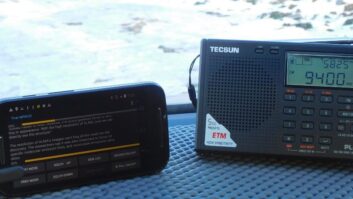Digital shortwave radio is no dream: It exists today. Right now, foreign-service broadcasters in Europe, Asia, Africa, Oceana and the Americas are providing regular digital radio broadcasts over shortwave, using the DRM30 transmission standard.
“The Digital Radio Mondiale AM solution operates worldwide,” said Ruxandra Obreja. She is chair of the DRM Consortium, the international not-for-profit group of broadcasters, transmitter/receiver manufacturers and broadcasting unions, who use and promote the DRM30 standard for short, medium and longwave and DRM+ for VHF. “In the past 18 months, India and Russia have already adopted it [DRM30] as their digital solution and have earmarked serious investment for its implementation.”
In July 2010, Indian public-service broadcaster All India Radio issued a tender for 40 new medium-wave and five new shortwave transmitters for DRM operation, as well as the upgrade of 36 other transmitters to support DRM30.
RELIABLE SYSTEM
DRM30 is meant to replace interference-prone analog AM broadcasting with a reliable digital signal that delivers high quality audio plus a host of data features. However, the system has been stymied by a limited availability of receivers.
DRM’s progress to date has been “very little in Europe and North America,” said Andy Sennitt, longtime shortwave radio watcher and editor in charge of the Radio Netherlands “Media Network” website. “Most emphasis now seems to be on India, China and South America.”
However, at the IBC2011 trade show in Amsterdam, the situation showed signs of changing.
At several events during the exhibition, the DRM Consortium highlighted new partnerships with receiver manufacturers that are expected to bring several new models to market over the coming year, including new standalone, USB-based, in-car and professional receivers.
Also, chipmaker Frontier Silicon announced that it was adding implementations of DRM30 and DRM+ to its Kino 3 radio processor, one of the most widely used digital radio IC chips on the market.
However, these positive signs have been a long time in coming.
Gerhard J. Straub, director of the Broadcast Technologies Division at the U.S. International Broadcasting Bureau (IBB); the agency that runs the Voice of America and Radio Martí, says the slow uptake of DRM30 are shared by all digital radio systems, which have not benefited from governmental mandates the way digital television has.
“I think the consumer is overwhelmed with media choices today and unless there is compelling content available on a specific platform, what incentive is there to migrate to a specific technology over another one?” he said.
Then there’s the issue of supply and demand: Broadcasters don’t want to switch to DRM30 unless there are enough receivers in use worldwide. Meanwhile, receiver manufacturers have been reluctant to commit to DRM, due to a lack of programming.
“DRM is not seen as a profitable line for the major manufacturers,” said Sennitt. “A few smaller manufacturers have produced DRM receivers, but the unit cost is still too high, and there simply aren’t enough DRM transmissions audible at any one location to stimulate consumer demand. It’s a classic chicken and egg situation — which comes first, the transmissions or the receivers? The broadcasters and the receiver manufacturers are each waiting for the other to move first.”
ADDITIONAL RECEIVERS
The decisions by Russia and India to adopt DRM30 for domestic broadcasting may be changing that equation.
“Our experience over the past year has been that chipset and receiver manufacturers are increasingly interested in creating DRM platforms or very often multi-standard platforms that accommodate several digital audio solutions including DRM,” said DRM Consortium Chair Ruxandra Obreja.
In fact, Obreja said. “Our membership has increased in the last 12 months and it is no wonder that the companies which have joined us are the top manufacturers of radio chipsets in the analog and digital world.”
Receiver partners MSway, Frontier Silicon, Chengdu NewStar Electronics and Himalaya all highlighted their DRM30/DRM+ receiver solutions during IBC2011.
With the potential DRM30 audience in India and Russia, use of the system in medium wave may prove feasible, but for shortwave it may be too late.
While DRM30 theoretically has what it takes to resurrect shortwave into a digital radio band, the real culprit behind shortwave’s decline is the Internet: After the Web arrived, many shortwave listeners had a better, far more reliable way to get the content they wanted. In the developed world, this killed much of the demand for shortwave broadcasts from international broadcasters.
In the developing world, however, the need for shortwave radio remains, but listeners do not have the money to buy expensive DRM receivers.
“Unless a company comes along with a DRM receiver that can cost less than $40 for countries in the developing world, it won’t happen,” said Keith Perron, founder of shortwave program producer PCJ Media.
In the context of a Web-dominated world, can DRM30 save shortwave radio? “Definitely not,” said Andy Sennitt. “There are too many other factors that have sealed the fate of shortwave.”
OTHER USES
Glenn Hauser, host of “World of Radio,” does hold out some hope for DRM30 on shortwave, seeing it being useful for “single-hop coverage at limited distances, as feeder to relay stations as with Radio New Zealand International to the Pacific.”
In fact, Thomson Broadcast demonstrated a DRM30-based rebroadcasting system at IBC2011 which would facilitate delivery to local FM stations programming via shortwave.
“Maybe we should ask that question from another angle,” says IBB’s Gerhard Straub. “If traditional shortwave broadcasting fades away, someone is going to use that spectrum for something, and we can be almost certain it is going to be used with a digital system. I think the DRM system has the ability to revitalize the HF spectrum, but I think it is up to the broadcasters to find a way to utilize the technology to give the audience something that they cannot get somewhere else.”
In response to these doubts, the DRM Consortium’s Ruxandra Obreja poses a question of her own: “Is there a demand for digital radio or will analog do? The obvious answer is that in a digital world, with very congested and limited spectrum resources, analog will be eventually replaced.” Under such conditions, “digital radio will thrive,” she predicted.











